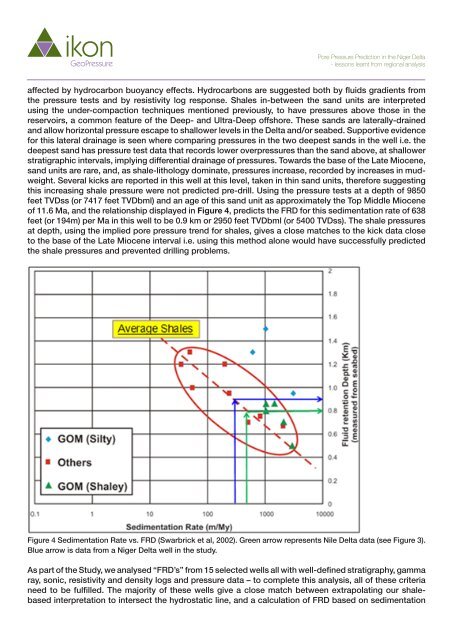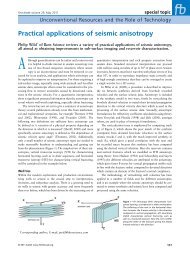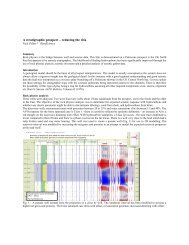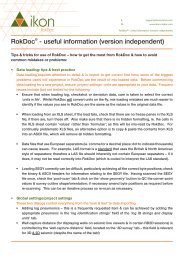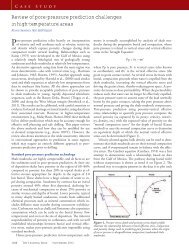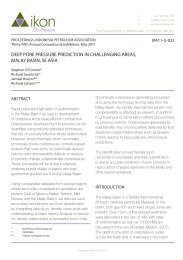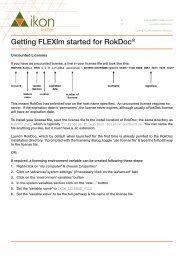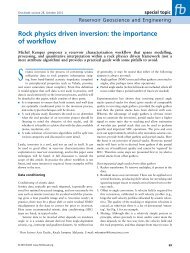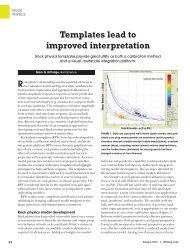pore pressure prediction in the niger delta â lessons ... - Ikon Science
pore pressure prediction in the niger delta â lessons ... - Ikon Science
pore pressure prediction in the niger delta â lessons ... - Ikon Science
Create successful ePaper yourself
Turn your PDF publications into a flip-book with our unique Google optimized e-Paper software.
Pore Pressure Prediction <strong>in</strong> <strong>the</strong> Niger Delta<br />
- <strong>lessons</strong> learnt from regional analysis<br />
affected by hydrocarbon buoyancy effects. Hydrocarbons are suggested both by fluids gradients from<br />
<strong>the</strong> <strong>pressure</strong> tests and by resistivity log response. Shales <strong>in</strong>-between <strong>the</strong> sand units are <strong>in</strong>terpreted<br />
us<strong>in</strong>g <strong>the</strong> under-compaction techniques mentioned previously, to have <strong>pressure</strong>s above those <strong>in</strong> <strong>the</strong><br />
reservoirs, a common feature of <strong>the</strong> Deep- and Ultra-Deep offshore. These sands are laterally-dra<strong>in</strong>ed<br />
and allow horizontal <strong>pressure</strong> escape to shallower levels <strong>in</strong> <strong>the</strong> Delta and/or seabed. Supportive evidence<br />
for this lateral dra<strong>in</strong>age is seen where compar<strong>in</strong>g <strong>pressure</strong>s <strong>in</strong> <strong>the</strong> two deepest sands <strong>in</strong> <strong>the</strong> well i.e. <strong>the</strong><br />
deepest sand has <strong>pressure</strong> test data that records lower over<strong>pressure</strong>s than <strong>the</strong> sand above, at shallower<br />
stratigraphic <strong>in</strong>tervals, imply<strong>in</strong>g differential dra<strong>in</strong>age of <strong>pressure</strong>s. Towards <strong>the</strong> base of <strong>the</strong> Late Miocene,<br />
sand units are rare, and, as shale-lithology dom<strong>in</strong>ate, <strong>pressure</strong>s <strong>in</strong>crease, recorded by <strong>in</strong>creases <strong>in</strong> mudweight.<br />
Several kicks are reported <strong>in</strong> this well at this level, taken <strong>in</strong> th<strong>in</strong> sand units, <strong>the</strong>refore suggest<strong>in</strong>g<br />
this <strong>in</strong>creas<strong>in</strong>g shale <strong>pressure</strong> were not predicted pre-drill. Us<strong>in</strong>g <strong>the</strong> <strong>pressure</strong> tests at a depth of 9850<br />
feet TVDss (or 7417 feet TVDbml) and an age of this sand unit as approximately <strong>the</strong> Top Middle Miocene<br />
of 11.6 Ma, and <strong>the</strong> relationship displayed <strong>in</strong> Figure 4, predicts <strong>the</strong> FRD for this sedimentation rate of 638<br />
feet (or 194m) per Ma <strong>in</strong> this well to be 0.9 km or 2950 feet TVDbml (or 5400 TVDss). The shale <strong>pressure</strong>s<br />
at depth, us<strong>in</strong>g <strong>the</strong> implied <strong>pore</strong> <strong>pressure</strong> trend for shales, gives a close matches to <strong>the</strong> kick data close<br />
to <strong>the</strong> base of <strong>the</strong> Late Miocene <strong>in</strong>terval i.e. us<strong>in</strong>g this method alone would have successfully predicted<br />
<strong>the</strong> shale <strong>pressure</strong>s and prevented drill<strong>in</strong>g problems.<br />
Figure 4 Sedimentation Rate vs. FRD (Swarbrick et al, 2002). Green arrow represents Nile Delta data (see Figure 3).<br />
Blue arrow is data from a Niger Delta well <strong>in</strong> <strong>the</strong> study.<br />
As part of <strong>the</strong> Study, we analysed “FRD’s” from 15 selected wells all with well-def<strong>in</strong>ed stratigraphy, gamma<br />
ray, sonic, resistivity and density logs and <strong>pressure</strong> data – to complete this analysis, all of <strong>the</strong>se criteria<br />
need to be fulfilled. The majority of <strong>the</strong>se wells give a close match between extrapolat<strong>in</strong>g our shalebased<br />
<strong>in</strong>terpretation to <strong>in</strong>tersect <strong>the</strong> hydrostatic l<strong>in</strong>e, and a calculation of FRD based on sedimentation


